Between Cinema I: The Movement Image, Cinema 2: The Time Image, and What is Philosophy, Deleuze elaborates an image of time, which he articulates through a variety of spatial metaphors encompassing facets, holes, contours, peaks and planes that inevitably not only connect but flow fluidly through each other. Generally speaking, Deleuze arrives at a formulation by literally ascribing a multi-dimensional and processually evolving form to relationships of concepts across, or rather, through time. To perpetuate Deleuze’s spatializing metaphor of time, we can imagine the movement-image as an inclinator (a type of elevator that can move horizontally and diagonally) that travels along the ‘contours’ of a plane of immanence, opening its sensory-motor doors onto minute ‘shots’ of a virtual plane of related images that we perceive and actuate through perception-images and action-images. With the time-image, however, the sensory-motor inclinator operates more like Willy Wonka’s glass elevator, or “Wonkavator,” that can move “up and down, sidways, slantways, and any other way you can think of” across layered planes of immanence, along the infinitely variable shafts of time. Recollection-images are the buttons that mobilize our movements across planes, and each ‘floor’ is a layer of a concept that connects all past images of said concept with their present and parallel peaks. As Deleuze explains in his repeated critiques of the cogito’s “I think therefore I am” rendering of the self, an “I” is always a concept and as such, according to Deleuze’s own architecture of concepts penetrating across sheets of time, this “I” is always a multiplicity. Or, in cinematic terms, a conceptual “I” is always a montage of laminated shots and component images. His elaboration of an “I” that projects onto multiple sheets of time – like an image projected onto multiply layered diaphanous screens superimposed upon one another – can only be conceived as a whole that is open, and without end.
Why, then, when describing “the dissimilar in the pure form of time” that constitutes “transcendent memory” in Difference and Repetition, does Deleuze delineate “an I fractured by this form of time” (DR 144)? How does the “fractured I” gel with the conceptual “I” that spreads across the time-image, that undergoes “metamorphosis” across concepts, people and things in the movement of world? Does not the idea of an “I” that is capable of being “fractured” either presuppose or entail a whole “I” that was or will be discrete? How does this differ or repeat the post-lapsarian fantasy of a whole “I” much contemplated by his intellectual forbears, along other planes of immanence? Shouldn’t Deleuze describe a fractal ‘I’ not a fractured ‘I’?
The “fractured I” that Deleuze describes evokes what I would call a “post lapsarian fantasy” of a once coherent whole riven by a fall from purity. In the case of social theory and philosophy, particularly of Kant, Hegel (see footnote 1), Lukács, and Lacan (see footnote 2), the whole constitutes the conceptually cohesive conceptualized “I” that is fragmented, fractured and fissured as it becomes social. Desire – for a thing, for recognition, for illusory and impossible wholeness, for communicative commensuration, in other words, for belonging – is always ecstatic, both emotionally and in its external orientation towards that which is outside, or Other. Deleuze describes this Other “not as another subject but rather the subject who becomes an other” (WIP 32). This first gap between a subject-self and subject-other maps onto the gap of necessity and desire, our original ‘lack’ (in Hegel and Kant’s formulation), that provoked our earliest agency and, in retribution for our profane insurrection, the (spiritual and philosophical) gods responded to by reifying our acts of violating wholes into the shattering of the respective unified world-bodies. This is true of the Eden and Aristophanes parables the aforementioned theorists mobilize and metaphorize into their theories of sociality-as-whole-splitters. The postlapsarian worlds that ensue are fated to unfulfilled nostalgia writ in the discrepancy between total and partial, ideal and actual, necessity and desire, monad and dyad, subject and object, and are rectifiable only in the telos-myth of reintegration. How, whether and by what poignant means we put the pieces back together, how we manage the agony of ecstasy (in all senses of the words) comprises the theoretical genome pervading the aforementioned authors’ respective projects. Deleuze’s designation of his conceptual “I” as a “fractured” one runs the risk of imputing an original or teleogical closable one-ness: only something once whole can be fractured, and fracturing implies potential reintegration.
Conceiving the effects of consciousness as it passes from an isolated thing-for-itself into a collective field of recognition as ‘splitting’ and ‘breakage’ cleaves a wound, or a gap, the awareness of which motivates the desire to heal. Kant was first to characterize a rift that separates the self into an apperceiving, “merely reflecting” self and a self partially externalized as “the object of perception” (Kant 1996, 18). Thus split, the uses of reason are segregated along public and private spheres. The Fall, in Kant’s formulation from “What is the Enlightenment?”, coincides with this split: the awakening of a desire for the ecstatic apple, and the choice to flout divine law and possess it, is the genesis of the self that is divided into a desiring self and a self-as-object that desires: an in-itself and a for-itself. Internal desire and the external regulation of desire within Eden, the yen to eat the apple and God’s prohibition of it, delves two selves within one Eve: one private and personal, one public and impersonal. Deleuze argues that, unbeknownst to Descartes, the cogito had this multiplicity of selves already ingrained and implied within its “condensation” of a ‘doubting I,’ a ‘thinking I’ and a ‘being I’ (WIP 25). Kant, however, “demands the introduction of a new component into the cogito, the one Descartes repressed – time. For it is only in time that my undetermined existence is determinable” (WIP 31). The self, determined in time as such, is a passive, malleable and impressionable one “that necessarily represents its own thinking activity to itself as an Other that affects it” (WIP 32). In so doing, Deleuze continues, Kant creates a new concept of “I” predicated on a new concept of time as a “form of interiority.”
If we plot Descartes’ cogito against Kant’s split-‘I’ we can begin to populate not so much the “image of thought” (WIP 39) but the architecture of thought that Deleuze conceives in the planes of immanence. Deleuze describes a layered field where PhilosophyT-1 offers a conceptual “IT-1” that moves as a “fragmentary whole” in and of itself along the plane of immanenceT-1 populated with a concept of non-interior, but anterior, TimeT-1. “IT-1” and TimeT-1 cannot nest into each other, but they do resonate together, with every movement of world, along the same plane: “every movement passes through the whole of the plane by immediately turning back on and folding itself and also by folding other movements or allowing itself to be folded by them, giving rise to retroactions, connections and proliferations in the fractalization of this infinitely folded up infinity (variable curvature of the plane)” (WIP 39). Kant’s split “IT” reverberates with a global movement of the plane that also passes through “TimeT”, as well as through other interrelated though orbiting concepts. Each plane, Deleuze tells us, is a “section of chaos” (ibid 42) much the same way a shot is a mobile section of a moving montaged whole. Because “no one plane could encompass all of chaos without collapsing back into it” (ibid 50), we must presuppose a “multiplicity of planes,” and every plane has its own manner of constructing immanence. “The plane of immanence is interleaved,” and it is “holed” to accommodate cross-traffic of concepts along each plane and across planes. Whether one concept of “I” precedes another in a synthetic linear concept of time is irrelevant; planes unite conceptual affinities or resonances across time. A Kantian and a neo-Kantian, a Hegelian and a neo-Hegelian vibrate harmonically along the same respective plane, yet bleed into each other across planes as well. “Philosophical time is thus a grandiose time of coexistance that does not exclude the before and after but superimposes them in a stratiographic order” (ibid 59). The concept “I,” under this cosmic configuration is never fractured by time, but always fractally configured in a ‘neighborly’ fashion along planes of immanence as well as across its many projected layers. This is a “fractal I.”
Let’s consider the following revised diagram I interpreted more as the architecture of the plane of immanence. We are looking at a section of the plane, and hence a section of a section of chaos, that exhibits some of the properties Deleuze describes: it has contours, it flows and folds, it has simultaneous peaks of present
Next, let’s plot“IT-1”, shown here as “i,” and“IT”, shown here as “I”
Both concepts coexist on their own plane and reverberate with other concepts, thereby translating their respective concept differentially across the plane (look closely and you will see I distributed both “I” and “i” parametrically across the surface):
POI for “I”
POI’s for both “I” and “i”
These planes do not persist in parrallel, of course, but transpose onto one another, such that an “i” is always immanently capable of bursting through an “I”
Note, too, that the planes intersect, and where they intersect there appears a whole. Not only does the movement of one plane pass onto another through this whole, but, if we consider each panel of “I” and “i” as both concept and thing, each then has its own layers:
Let’s take a closer look:
Between each “i” and “I” there are infinite possible mutations of the two. And, finally, between each plane their are infinite other possible planes of immanence that can refract and fractalize any concept “I”:
Finally, Deleuze’s ruminations on recollection-images and dream-images introduces new dynamics of movement that describe, again, less a fractured “I” than a an ‘I’ refracted through images and things in time. Beyond the distribution of the philosophical concept “I” across planes of immanence, recollection-images and dream-images move our personal trajectories of “I” through zones of dreams, thoughts and fantasies that we identify with particular features of an outside thing, which is itself interleaved and holed. The relations of associations, or relation-image, in such movements transcends the actuality of the sensory-motor schema and dives directly into virtual connections fashioned through what Bergson calls “attentive recogntion: “my movements…revert to the object, return to the object, so as to emphasize certain contours and take ‘a few characteristic features’ from it” (44). Like refraction, a movement does not simply bounce (reflect) or disintegrate (fracture) upon transmission to another object, but transfers and transmutes through that other object as it extracts movement from it, be it present or past, and then continues its altered course back through the perceiving subject. This refraction of not a movement but what Deleuze calls “movement or world,” that “supplements the movement of the character” (TI 59), is likened to Gene Kelly’s dance that transmutes the movement of misaligned paving slabs into the embodied gestures of the dancer. An “I” is neither broken nor monolithic, but in its movement of world through other things, and the “infinite number of planes or circuits which correspond to its own ‘layers’ of its aspects” (ibid 46), the “I” undergoes unbroken and processual transference through “metamorphosis” (ibid 62). The “I” disperse and differentially articulated across and through planes of immanence and metamorphosed through the planes of other things is both “fractal” and “refracted,” never “fractured” by time.
[1] For Hegel, dissolution is the basis of Life as it unfolds through dialectical recognition: “the simple substance of Life is the splitting-up of itself into shapes and at the same time the dissolution of these existent differences.” Consciousness only comes together after falling apart in interaction. A self-consciousness greets another self-consciousness and walks away divided, but with a pulsating social lobe. A Hegelian self-consciousness recognizes itself in how it sees an other self-consciousness seeing it and walks away something of its former self maintained but with features ended, and both self-consciousnesses are more same to each other than to their prior selves. The “breaking” up of an Idea releases it from habituated form and returns it to its constituting “moments,” and this “dissolution is the power and work of the Understanding.” Hegel describes this essential, ongoing and progressive falling apart of the concrete-non-actual—the Babel-like habitat of Spirit—as “breaking,” “dismemberment” and “death.” Hegel’s recurrent falling apart predicates an ongoing and inverse coming together, which will fall apart again, that distinguishes the temporal conditions of his conception of historical progress from those of Kant’s.
[2] Lacan introduces an unattainable fetishized whole that we experience in the mirror stage: in our utmost innocence we are drawn ecstatically towards a foreign thing that configures its externality to our internality, our Innenwelt to its Umwelt, its objectivity to our subjectivity, and in so doing carves a hollow core in our self-consciousness. The virtual imago of a circumscribed body becomes an icon for an origin myth of a whole-state forever distant that, unlike in previous unbecoming becomings, we will always asymptotically fall short of attaining. The imago was never real and never reducible nor fundamental to the subject. The imago and its reification in a modular I can only ever orbit the axis of the Real within the Lacanian triad that is the basis of all meaning-making. After the mirror stage, the baby progresses into the Symbolic, where his subjectivity will be recursively fragmented across a third party order of signification that systematizes the gap between partial and whole recognition—the resulting volume belonging to the “function of misrecognition.”Consciousness of the gap within our own self-consciousness, or the recognition of our inevitable misrecognition, though in the Mirror stage’s case irresolvable, is the common protein that fuels the desire to persevere through the pain of self-alienation in postlapsarian fantasies.
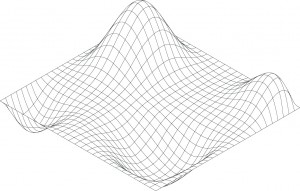
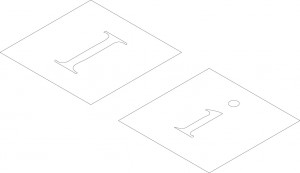
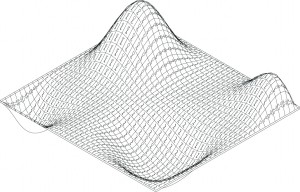

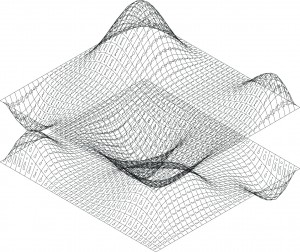
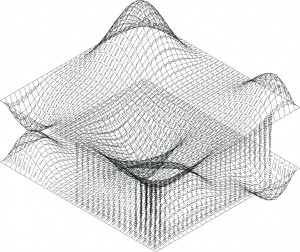
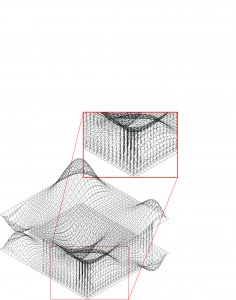
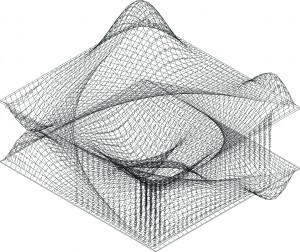
Again, you provide us with inspirational “diagrams”! ☺ I read your post as a quite complicated yet informative account of what it means to be a subject in time for Deleuze, and how to account for that as a “conceptual I.” For myself, I never had a worry that Deleuze’s picture of the “fractured I” implied some pre-lapsarian wholeness of the self. Rather, it is the case, I think, that Deleuze (and Kant) are interrogating lines in the history of philosophy that insist on the indivisible identity of the self as substance. For me the problem might lie elsewhere. Whether Descartes or Deleuze, we have conceptions that are bedrock formulations that are the limits of the concept: for Descartes the self as substance; for Deleuze the division that always makes I an Other. These are something like metaphysical constants in both cases, from which all further arguments and ramifications derive.
But having said that, I like very much how you work though the implication of a fractal or refracted account of the conceptual I. I actually don’t see anything in Deleuze’s own writing that disallows or contradicts your alternative account. It is rather the case that you have provided us with a more nuanced and complexly ramified account of the divisions, splittings, and refractions that this I may undergo under the force of time. Although we are not discussing this book, it would be great to bring The Fold: Leibniz and the Baroque into your account. The argument here seems closely allied to your picturing of these transformations as complex folds and secant or serpentine lines passing through different planes. Fascinating!